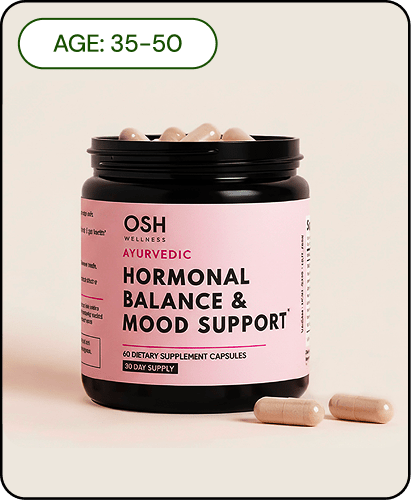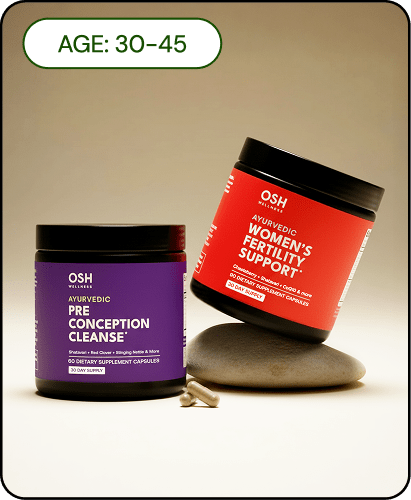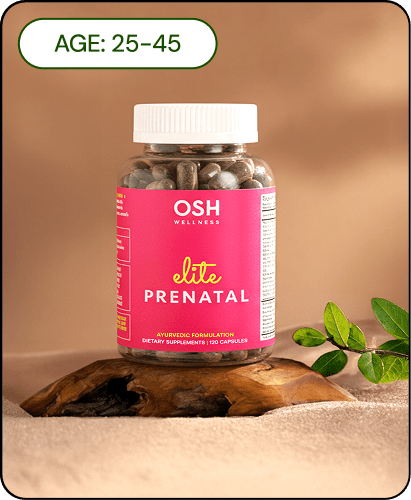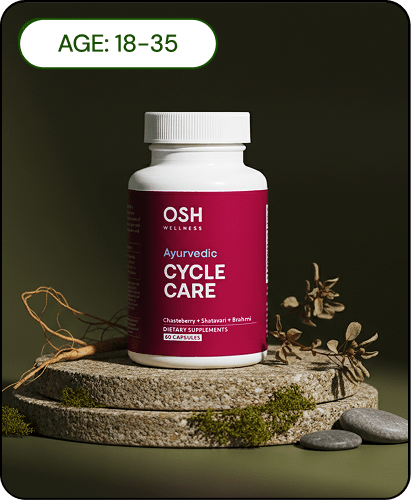Last Updated: Sept 30, 2025
Table of content
The well-being of new mothers is at the heart of the centuries-old practice of Ayurveda. The ‘science of life,’ Ayurveda, offers a holistic set of guidelines on caring for new mothers and restoring the delicate balance of energies within the postpartum body.
According to Ayurveda, the human body is made up of three energies or doshas – vata which consists primarily of air (and space), pitta, which consists of fire (and water), and kapha which consists of water (and earth). The process of childbirth creates an empty space within the womb, giving air the opportunity to occupy this space and causing an imbalance in the vata energy. This is manifested as anxiety, dryness, gas, constipation, bloating, and interrupted sleep. Ayurvedic postpartum care is designed to harmonize the new mother’s vata.
Additional reading: The Chopra Center has a simple overview on understanding vata, here.
These principles have their roots in an ancient world, where multiple families lived together under one roof, and everything from food and cleaning products to medicines was made from raw ingredients within the household. There were many hands to help during the postpartum period, making it possible (in fact, it was strictly required) for the new mother to rest and recover. Quite literally, the village came together to help out.
Many of these traditions continue today, influencing how new mothers are expected to rest, what they eat and drink, how their bodies and bones are cared for, how lactation is supported, and so on. Most of the traditions have evolved over the centuries as to different cultures, geographies, climates, diets, family structures, and – perhaps most dramatically – the changing role of women in society.
From the first week postpartum and onward, this is what Ayurvedic care looks like and the wisdom behind the various practices.
1. Rest, rest, rest

New mothers and babies are advised to rest at home for 40 days or six weeks to avoid coming in contact with external energies that may influence the well-being and health of the mother and baby. It’s common for new mothers to return to their mother’s homes for this period or for family members to come over to help with the baby and with household tasks like cooking and cleaning. Beyond this, visitors are limited to allowing the mother to rest and protect her and the baby from possible infections.
Years ago, this was a strict restriction, and complete bed rest was mandated. Today, it’s harder to slow down, and it’s common to step out for things like doctor’s appointments and registering a baby’s birth. However, care must be taken to make sure the mother gets as much rest and help as she possibly can.
Motherhood is exhausting and overwhelming, especially in the first few days – in Ayurvedic care, the support network ‘mothers’ the mother and allows her to make time for herself.
2. Cover the ears, and keep warm.
The ears are regarded as an entry point for air to enter the body. To prevent an imbalance of the vata, new mothers (and babies) are advised to plug their ears with cotton. Keeping feet warm can also help balance vata.
This is also one of the reasons why the new mother’s stomach is physically bound postpartum– to prevent the entry of excess air. More on this soon, in a post on Ayurvedic care in the second week postpartum.
3. Create a calm environment with positive energy.

According to Ayurveda, the connection between new mothers and babies is very strong, and stimulus that a woman experiences when pregnant can influence the baby. This is why pregnant women are advised to opt for positive television shows, movies, books and so on. This concept continues into the postpartum period as well. New mothers are recommended to create soothing environments and maintain positive thoughts, especially while breastfeeding.
Environments should be kept warm, and the flow of wind should be controlled to protect the balance of the mothers’ vata.
4. Revitalize the digestive system with special dietary guidelines.

While guidelines and recipes can vary immensely amongst different Indian sub-cultures, a common theme does emerge. New mothers should have freshly prepared warm, soft and soupy foods that are that are easy to digest, balance vata and restore agni (the digestive fire). Foods are rich in ghee to promote digestion, keep energy levels high and to ensure stools are soft. Foods are also rich in herbs and spices that expel gas and support lactation. For example, black pepper and ginger are preferred spices among some, and most avoid chilies.
Foods that are hard to digest or that cause bloating and gas, such as toor dal, chana dal, raw greens, cauliflower, chickpea and beans, should be avoided completely to maintain a balance in the new mother’s vata.
Some communities encourage new mothers to drink meaty broths, bone marrow soups and lots of milk ( my traditional dai ma – midwife – recommended I drink 2 liters of milk a day, everyday!) Khichadi is a popular meal during first few weeks postpartum as it is easy to digest and provides the much needed iron and protein to mother's body. See an easy khichadi recipe here.
Dietary guidelines are stricter in the first two to four weeks postpartum, and new foods introduced after this period.
According to Ayurveda, a mother’s diet influences the quality of milk and health of the baby. Accordingly, new foods are introduced to the mother’s diet one at a time to check the response of the baby, if any.
5. Snack frequently to maintain energy levels
A breastfeeding newborn will nurse around the clock, which can be draining on the new mother. Snacks like nuts, ghee-rich laddoos, protein-rich foxnuts, and nut-based halwas (an Indian sweet dish) are typically kept at hand for new mothers to munch on throughout the day (usually at the insistence of well-meaning relatives along with reprimands for daring to think of weight-loss at such a time - the establishment of breastfeeding and milk supply take priority).
6. Stay hydrated with special teas to promote lactation.

Breastfeeding mothers are encouraged to sip on warm water and drink warm teas to stay hydrated. The teas are typically a concoction of galactogogues (herbs that stimulate milk production) which also tend to aid in digestion, such as mehti (fenugreek seeds), saunf (fennel), jeera (cumin), ajwain (caraway) and Shatavari. These herbs and spices can be added to food as well.
Turmeric milk (Golden Milk), often mixed with ginger, is frequently consumed too. Turmeric is a powerful anti-inflammatory that is highly recommended for new mothers. It also helps in avoiding clogged milk ducts and swollen breast tissue for mothers who breastfeed.
Ashwagandha tea is also a common tea given postpartum, as it helps in reducing stress and anxiety. Ayurveda also recommends dashamoola tea, which is made with 10 roots and helps in removing excess vata from body and regain strength and vitality.
Additional reading: The School of Medicine and Public Health at the University of Wisconsin-Madison has an informative outline of natural galactagogues, including those mentioned above, here.
Read more about Ayurvedic postpartum care in our next post here.
Related Products
Ayurvedic Lactation & Postpartum Support
Freshly Moms Organic Lactation and Postpartum Support is the most effective way to boost milk production naturally.
Golden Milk for Motherhood
Made with Ayurvedic ingredients, including Ashwagandha, Golden Milk for Womanhood helps new mothers with postpartum recovery, better sleep, and a balanced mood.
Posted by Nidhi Chimnani
Nidhi is a fresh mom who has lived in over 8 countries and has experienced several cultures closely. She was editor-in-chief of an established magazine for several years. She currently lives in Dubai and writes a blog about her experience with baby stuff.







